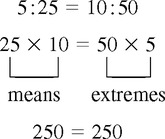CHAPTER 4 After reviewing this chapter, you should be able to: 1. Define ratio and proportion 3. Calculate problems for a missing term (x) using ratio and proportion
Ratio and Proportion
SOLVING FOR x IN RATIO AND PROPORTION
Steps:


















